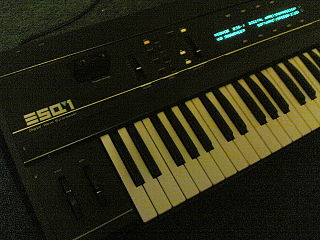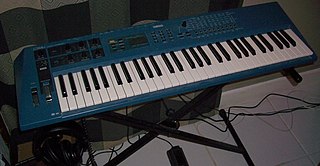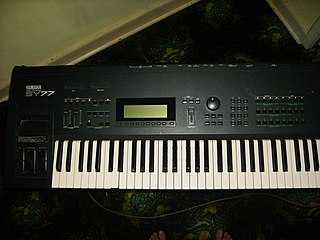
An electronic keyboard, portable keyboard, or digital keyboard is an electronic musical instrument, an electronic or digital derivative of keyboard instruments. Broadly speaking, the term electronic keyboard or just a keyboard can refer to any type of digital or electronic keyboard instrument. These include synthesizers, digital pianos, stage pianos, electronic organs and digital audio workstations. However, an electronic keyboard is more specifically a synthesizer with a built-in low-wattage power amplifier and small loudspeakers.

The Roland JX-3P is a synthesizer produced by Roland Corporation of Japan from 1983-1985. The "3P" in its name refers to "Programmable Preset Polyphonic". It is notable as one of the company's first synthesizers to incorporate a MIDI interface.

Ensoniq ESQ-1 is a 61-key, velocity sensitive, eight-note polyphonic and multitimbral synthesizer released by Ensoniq in 1985. It was marketed as a "digital wave synthesizer" but was an early Music Workstation. Although its voice generation is typically subtractive in much the same fashion as most analog synthesizers that preceded it, its oscillators are neither voltage nor "digitally controlled", but true digital oscillators, provided by a custom Ensoniq wavetable chip. The signal path includes analog resonant low-pass filters and an analog amplifier.

The Yamaha CS-80 is an analog synthesizer released in 1977. It supports true 8-voice polyphony, with two independent synthesizer layers per voice each with its own set of front panel controls, in addition to a number of hardwired preset voice settings and four parameter settings stores based on banks of subminiature potentiometers.
The Yamaha AN1x is a DSP-based analog modeling synthesizer, produced by Yamaha Corporation from 1997 to 1998, and was marketed as an "analog physical modelling control synthesizer".

A stage piano is an electronic musical instrument designed for use in live performance on a stage or a studio, as well as for music recording in jazz and popular music. While stage pianos share some of the same features as digital pianos designed for home use and synthesizers, they have a number of features which set them apart. Stage pianos usually provide a smaller number of sounds, with these sounds being of higher quality, unlike regular digital pianos and home synthesizers.

A MIDI keyboard or controller keyboard is typically a piano-style electronic musical keyboard, often with other buttons, wheels and sliders, used for sending MIDI signals or commands over a USB or MIDI 5-pin cable to other musical devices or computers. MIDI keyboards lacking an onboard sound module cannot produce sounds themselves, however some models of MIDI keyboards contain both a MIDI controller and sound module, allowing them to operate independently. When used as a MIDI controller, MIDI information on keys or buttons the performer has pressed is sent to a receiving device capable of creating sound through modeling synthesis, sample playback, or an analog hardware instrument. The receiving device could be:

The Yamaha Motif is a series of music workstation synthesizers, first released by Yamaha Corporation in August 2001. The Motif replaced the EX series in Yamaha's line-up and was also based on the early Yamaha S series. Other workstations in the same class are the Korg Kronos and the Roland Fantom G. The series' successor is Yamaha Montage.
The Yamaha SY85 is a digital music workstation introduced in 1992. Unlike other Yamaha synthesizers of the time the SY85 does not use FM synthesis. Instead, its sounds are based on samples, which can be layered and modified to create new sounds.

A guitar synthesizer is any one of a number of musical instrument systems that allow a guitarist to access synthesizer capabilities.

The Yamaha CS1x is a sample-based synthesizer released by the Yamaha Corporation in 1996.

The Yamaha CS2x is a sample-based synthesizer released by the Yamaha Corporation in 1999. The CS2x is designed for maximum real-time control, according to Yamaha. It is the successor of the very successful Yamaha CS1x. Enhancements include 64-note polyphony, a bigger sample ROM and a 24 dB/oct LPF/HPF filter. The CS acronym stands for Control Synthesizer.

Roland JX-8P is a 61-key, velocity- and aftertouch-sensitive, six-note polyphonic, fully analog synthesizer released by Roland in 1985. In a time of rising popularity of digital frequency modulation synthesizers, such as Yamaha DX7, JX-8P was marketed as the best of both worlds: while it was possible to create classic analog synth sounds, several new modulation parameters and redesigned hardware enabled it to produce certain types of sounds associated with FM synthesis, such as metallic percussive sounds. Likewise, traditional hands-on controls were replaced with a DX-style interface with membrane buttons and one "edit" slider.

Yamaha SY77 is a 16 voice multitimbral music workstation first produced by Yamaha Corporation in 1989. The SY77 is a synthesizer whose architecture combines AFM synthesis, AWM2 for ROM-borne sample-based synthesis, and the combination of these two methods christened Realtime Convolution and Modulation Synthesis (RCM). The same technology was also packaged in a rack-mounted module released simultaneously, the TG77.
The Yamaha MO6/MO8 is a music production synthesizer that comes in two sizes. The MO6 is the 61-key while the MO8 is the 88 weighted key version. The two versions use Yamaha's AWM2 tone generator also used in the Motif and the Motif ES series of synths and comes with 175MB of waveform memory, 64 voices of polyphony, 512 preset programs with 256 User voice and 129 GM voice, over 1700 arpeggio programs, and over 18 different filter types navigated through the 240x64 LCD display.
The Yamaha SY99 is a synthesiser combining frequency modulation synthesis and sample-based synthesis and the direct successor to Yamaha's SY77/TG77. Compared to the SY77, it has a larger keyboard at 76 keys instead of 61, a larger ROM with more in-built AWM samples, the ability to load user-specified AWM samples into on-board RAM, an upgraded effects processor, and several other enhanced features.
The Alesis Quadrasynth is a 76-key, 64-note polyphonic PCM sample-based digital subtractive synthesizer first introduced in 1993. It was Alesis's first major foray into synthesizer production.

The Split-8 is a polyphonic analogue keyboard synthesizer manufactured by Sequential Circuits. Built in Japan and going by the alternative name "Pro-8" in some markets, this was one of the last synthesizers produced by the company and was assigned model number 608. It was released in 1985 at a list price of $1,199. This and some other Sequential Circuits synthesizers were built around the Curtis Electronics CEM 3394 "synth-on-a-chip" integrated circuit, and used a Z80 as their central microprocessor.

The AX60 is a polyphonic analogue keyboard synthesizer manufactured by Akai Professional in the mid-1980s. It was Akai's answer to the popular Roland Juno series synthesizers. The AX60 uses voltage-controlled analogue oscillators and filter circuitry based on the Curtis Electronics CEM 3394 integrated circuit.

The Yamaha DX21 is a digital controlled bi-timbral programmable analog synthesizer with a four operator synth voice generator which was released in 1985. It uses sine wave-based Frequency Modulation (FM) synthesis. It has two FM tone generators and a 32-voice random-access memory (RAM), 32 user voices and 128 read-only memory (ROM) factory preset sounds. As a programmable synth, it enables users to create their own unique synthesized tones and sound effects by using the algorithms and oscillators. The instrument weighs 8 kg (17.6 lbs). On its release, it sold for $795.















